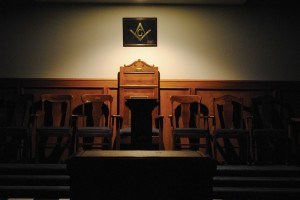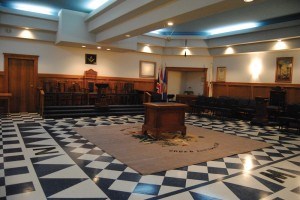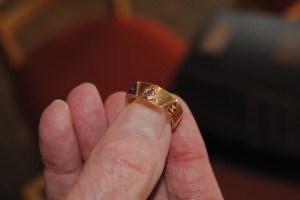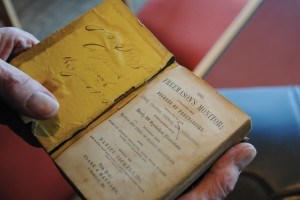
Tucked away amongst shops and restaurants on Connaught Drive stands an unassuming door.
To the untrained eye the glass door is easy to overlook, if not for the blue sticker of the Masonic Square and Compasses—the most recognized symbol of Freemasonry.
Steeped in history, symbolism and ritual, Freemasonry is the largest fraternity in the world and has been a part of the Jasper community since 1925.
With 75 active members, the group of men has kept a low profile over the years, quietly holding meetings every third Thursday of the month, except for July and August, and has donated money to a number of community groups and organizations.
“The bottom line with Masonry is fellowship and brotherly love, and we certainly try to better our standards as husbands, fathers and brothers,” said Harry Home, the worshipful master of Jasper Park Lodge 143.
Often misunderstood as a secret society, the origin of Freemasonry is the subject of intense speculation. The general consensus amongst Masonic scholars and researchers, however, is that Freemasonry likely arose among stonemasons who built the great cathedrals and castles in Europe during the middle ages.
At the time there were no trade unions or recognized trade credentials, so stonemasons adopted secret signs and words to prove they were trained masons when they moved from one site to another, according to the Grand Lodge of Alberta.
Over time, demand for new churches and castles declined and fewer stonemasons were needed. As a result, the group started welcoming upstanding men with no connection to the trade to join them in their conclaves—usually held at pubs, explained Sandy Robinson, a Freemason for nearly 50 years and former worshipful master of Jasper Park Lodge 143.
Eventually they began calling themselves Freemasons, and by 1717 the first “organized” Freemason Lodge was established—the Grand Lodge of England.

Today, thousands of books and articles have attempted to expose the inner workings of Freemasonry, particularly the group’s rituals, which have remained relatively guarded from the public’s eye.
“It’s a fraternal order with ritual secrets,” said Robinson.
“The secret society has been overworked by a lot of people,” said Home. “The reason it’s secret is because we want only Masons in our lodge, that’s all.”
At its core, Freemasonry follows three principles: brotherly love, relief (charity) and truth.
Using these guiding principles, Freemasons believe in “making good men better” and believe these principles represent a way of achieving higher standards in life.
As a non-religious and non-political group, it steers clear of touchy topics and forbids members from promoting their own personal interests. It also places a Freemason’s duty as a citizen over their obligation to other Freemasons.
“It’s a temple of peace,” said Home.
“Politics and religion both foment argument and we don’t want argument within the walls of the lodge,” said Robinson.
Inside Jasper Park Lodge 143, which is located underground, there are several “festive rooms”, including a full size kitchen, a dining room with space for nearly 50 people and a lounge with several comfy chairs. Strewn on the walls are Masonic symbols and scriptures.
Most impressive, however, is the lodge room, where official meetings and ceremonies are held.
The square room, with black and white tiles and wood paneling, is laid out east to west and north to south to reflect King Solomon’s Temple. In the centre of the room is an alter where a Bible or other holy book is usually laid opened. This book is referred to as the Volume of Sacred Law.

The Master of the Lodge sits in the east end of the room on a raised platform of three steps where he presides over the meeting. Beside him to his left, sits the immediate past master and to his right special guests. Opposite the master, on the west side of the lodge, sits the senior warden, who is second in charge, and sits on a raised platform of two steps. The junior warden sits on the south side of the lodge on a single raised platform and the chaplan sits in the north end of the room. Wooden chairs line the perimeter of the room.
In addition to the seating arrangements, the room is full of Masonic symbolism, including two tall pillars with globes on top. The pillars were prominent architectural features of Solomon’s Temple and stand on either side of the senior warden.
A letter G also hangs over the alter to represent God and the lodge’s original constitution hangs on the wall to the left of the master’s chair.
Many of the details in a Masonic Lodge reflect different aspects of King Solomon’s Temple, as described in the Holy Bible. The temple was built in the 10th century B.C. on Mount Moriah in Jerusalem and stored the sacred Ark of the Covenant, which were said to contain the tablets of the Ten Commandments given to Moses by God.
Early stonemasons claimed their work originated with the great construction projects of the Bible. When Freemasonry became an organized fraternity in the 1700s, Masons developed ceremonies and practices based on alegory and symbolism of Solomon’s Temple to help teach moral and spiritual ideas.
More than 300 years later, those same teachings are followed today and introduced as rituals when someone wants to become a Freemason.
To become a Freemason, men over the age of 21 must meet several qualifications, including a belief in a supreme being, while meeting standards of character and reputation and being of good moral character, according to the Grand Lodge of Alberta
“We don’t solicit members, but we welcome people to join,” said Home.
“Every phonebook in the country has a Masonic Lodge listing,” said Robinson, adding people can also join by going online.
In addition to these basic qualifications, a new member must be recommended by two members of the local lodge and must understand his character will be investigated, including whether he has a criminal record and pays his bills.
At its most active, Jasper Park Lodge 143 had 143 members, a coincidence that wasn’t overlooked by Robinson.
“It stayed there for the longest time,” said Robinson, “One-hundred and forty-three members in lodge 143. I always found that unique.”
In the last 20 years membership has dwindled as members age and people become occupied with other things.

“Church attendance has dropped off and our Masonic attendance has dropped off and we’re getting old and longer in the tooth, but I’m an eternal optimist and my read as the master of the lodge is that we’ve got interest from younger people coming up,” said Home.
To become a Master Mason—the highest level of attainment—there are three degrees that must be obtained. The first degree is called an Entered Apprentice.
Although neither men would speak openly about what this entails, both admitted it involves a lot of memorization.
“If we could live up to the first degree, in my humble opinion, there would be no more wars. It preaches humanity to each other,” said Home.
The second degree is called the Fellowcraft and the third, and final degree, is Master Mason.
“The sublime degree of a Master Mason is to me the most important degree of them all because when you go back in history you weren’t able to get that for quite some time,” said Home, who is now a 32 degree Master Mason.
In addition to the three degrees, there are other Masonic degrees called “additional” or “appendant,” because they add to the foundations established in the first three degrees and are not considered superior to the Master Mason degree, according to the Grand Lodge of Alberta.
At Jasper Park Lodge 143, the initiation fee costs $250 and includes a Masonic apron, considered a badge of honour among Freemasons.
“Stonemasons wore a leather apron so they didn’t wear their clothes out so fast,” said Robinson, explaining the apron’s significance.
In addition, members are also expected to pay an annual fee of $100.
“It’s a wonderful fraternal atmosphere. You can go anywhere there’s a lodge and if you can prove yourself and show you’re paid up, you can visit anywhere in the world,” said Robinson.
“You get welcomed as if you’re a long lost friend.”
Paul Clarke [email protected]
